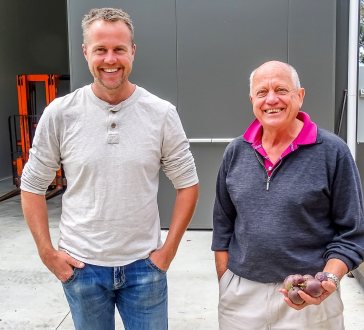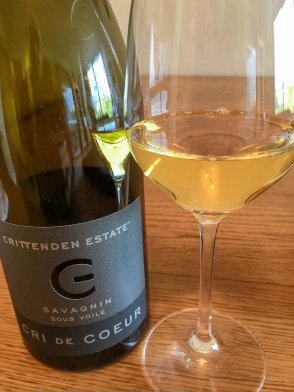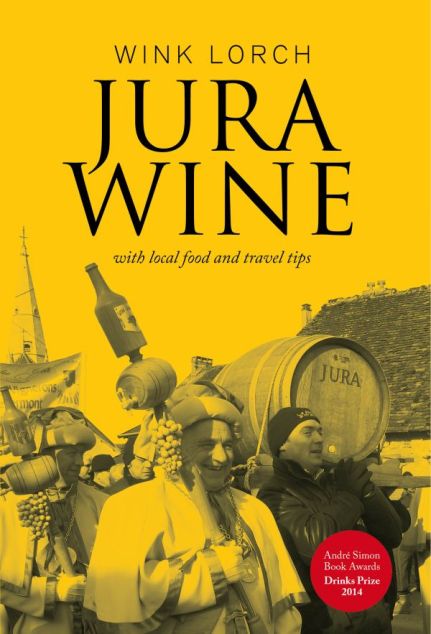In the past year I’ve had the chance to try several Jura-inspired wines of the world. By this, I mean wines made with the Jura grapes Savagnin or Trousseau, grown outside France and/or wines inspired by Jura’s oxidative methods.
Traditionalists in the Jura wine region tend to become very worried by talk of any trend like this – there are even laws to stop other AOC wine regions in France using these grapes. The same attitude is held by the Savoie AOC authorities about that region’s indigenous varieties. For this outsider, at any rate, this viewpoint is ridiculous – not only do we all know that imitation is the sincerest form of flattery, but it provides wonderful publicity for the original; drinkers who discover the newcomers often want to try the original.
In the Jura Wine book I wrote about these wines briefly in Appendix 3, telling the stories of the emergence of California Trousseau and Australian Savagnin. If you own the book, do take a look; and if you don’t, order the book direct from my site Wine Travel Media (quicker and usually cheaper than Amazon) – the book is still over 90% up to date despite being already three years old! Since the book was published, several other Trousseau and Savagnins have appeared on my radar, so below are some brief thoughts and comments.
 TROUSSEAU
TROUSSEAU
In what seems like a wonderfully low-key ‘first’, Jason Lett of The Eyrie Vineyards (famous for its Pinot Noir, pioneered by Jason’s father David Lett in the 1960s) was the first in the Willamette Valley of Oregon to have released a Trousseau wine last year. Having tasted Jura Trousseau, Jason thought it might be ideal to plant the grape in the region and he’s not alone. A small group of Oregon wineries has followed suit planting Trousseau, including Analemma in the Columbia Gorge, whose worthy attempt I tasted from demijohn. Even amphora-specialists Beckham Estate of Willamette Valley are planting it… I see an Oregon-Trousseau trend emerging. At a tasting at Eyrie last August, Jason revealed his first release, the 2015 Eyrie Vineyards Trousseau and it was spot on – pale-coloured with a blueberry character, some earthy notes and good acid grip. He made it with no added sulphur.
On a brief trip to Porto last year, we visited the enjoyable wine bar PROVA a couple of  times and I purchased a bottle of Conceito Bastardo 2014 to take home. Sporting a delightfully original label, it was young so has lain in our cellar until a few weeks ago, when I opened it, yearning for a break from Savoie and Bugey wines, which I’m tasting at full-stretch in preparation for the next book, Wines of the French Alps.
times and I purchased a bottle of Conceito Bastardo 2014 to take home. Sporting a delightfully original label, it was young so has lain in our cellar until a few weeks ago, when I opened it, yearning for a break from Savoie and Bugey wines, which I’m tasting at full-stretch in preparation for the next book, Wines of the French Alps.
If you weren’t aware, Portugal’s Bastardo is genetically identical to Jura’s Trousseau, even though several growers in the Jura emphatically deny it is possible. Although Portugal has over 1,000 hectares there are few wines from 100% Bastardo, as much is grown in old mixed vineyards in the Douro and used for blending, usually for Port. This varietal example is from the Conceito winery (the brand name means ‘concept’) based in the Douro Valley. Wine Grapes has little good to say about unfortified varietal Trousseau, but this wine is a cracker, with light colour, a cherry-like nose, good acidity, balanced alcohol (13.5%) and lovely fruit. It was definitely less rustic and earthy than a Jura Trousseau, but a really enjoyable wine.
SAVAGNIN
Late last summer on a visit to the Haute Savoie vineyards just south of Lac Léman, I finally went to the biodynamically-run estate Les Vignes de Paradis, owned by Dominique Lucas, one of the up-and-coming Savoie stars. For me, the excitement lies in his range of Chasselas from the vineyards of Crépy, Marin and Marignin which he is making better than anyone in the region (more in the book to come). However, he has also planted a range of other varieties including Savagnin. Les Vignes de Paradis 2015 Savagnin IGP des Allobroges, which I tasted from that very hot vintage, had been made in concrete egg and weighed in at a hefty 14.5%, but it wore it well, with the wine showing surprising crispness and ripe lemon curd flavours. It had been open more than a week, yet was alive and kicking. An oddity, sporting a high price tag, it proved yet again what a magical grape this is.

Dominique Lucas of Les Vignes du Paradis is ever the experimenter – the camera and hand belong to Mick Rock, photographer, shooting for the next book.
An enjoyable diversion at the Oregon stands at London’s Real Wine Fair, led me to taste Coury Old Vine Savagnin Rose from Jeff Vejr’s Golden Cluster winery. I’m including it here even though Savagnin Rose [no accent!] is not grown in the Jura as far as I know – surprisingly it is not the same as the Savagnin Muscaté grown by a few growers like Marnes Blanches (for its cuvée Savagnin Le Jensillard) in the Sud Revermont, but instead is the non-aromatic version of Gewurztraminer, known best in Alsace as Klevener de Heiligenstein. All are genetically identical, though. From a vineyard planted 50 years ago by a pioneering rare grape grower in Oregon, Charles Coury, honoured by Jeff Vejr in several of his fascinating wines, this Savagnin Rose was simply-speaking delicious – a triumph for this rare grape.
Garry Crittenden is a brilliantly persistent marketeer and one of those who did much to put Australian wine on the map in the UK especially 25 years ago. His son, Rollo is an excellent winemaker and Garry’s successor at Crittenden Estate in Victoria’s Mornington Peninsular region – he is also a huge Jura wine fan. Thanks to both Garry and Rollo, I was able to taste their very first vintage of sous voile (oxidative, under-the-veil-of-yeast) Savagnin 2011, named Cri de Coeur before I published Jura Wine so I wrote about it in that appendix 3. And, they hosted Brett and I for an all-too-fast visit when I was in Melbourne in early 2015 when we were able to taste the 2013 while still in barrel. In May, clever Garry alerted me to the fact that Jancis Robinson MW had a spare sample bottle of the Crittenden Estate Cri de Coeur Savagnin 2013, so as I was briefly in London, off I went to retrieve it so that I could taste it, giving it to others blind at the end of a celebration tasting for the success of the Kickstarter campaign for Wines of the French Alps.

Rollo and Garry Crittenden. © Brett Jones.
This is a part of what I wrote to Garry afterwards: “I tasted this with a group of wine educators and keen wine consumers last night AFTER a whole series of Savoie and other French Alps wines and for many, after a long day of tastings! I gave it to them blind stating it had nothing to do with the French Alps. First reaction, especially on nosing it, from several, was – well, it must be Jura (of course, they were a little biased being in my house!), so I said no and they agreed it was oxidative but probably not Sherry. Then the palate surprised because it appears ‘sweeter’, but see below. Everyone was intrigued and most of them, impressed.
So, now I’ve re-tasted it – I had meant to open it early last night but it never happened, so  now it’s been open 24 hours. For me it shows some walnuts and even classic spices, such as ginger and turmeric on the nose; on the palate, it is not as aggressive as some Jura oxidative Savagnin, showing almost sweetness, but it’s more of a textural creamy sweetness rather than sugar. The finish is very long and I see no reason for it not to age well for several years. A great success and much more Jura-like than the previous incarnation, but still shows the extra warmth of your location. Congrats to Rollo.”
now it’s been open 24 hours. For me it shows some walnuts and even classic spices, such as ginger and turmeric on the nose; on the palate, it is not as aggressive as some Jura oxidative Savagnin, showing almost sweetness, but it’s more of a textural creamy sweetness rather than sugar. The finish is very long and I see no reason for it not to age well for several years. A great success and much more Jura-like than the previous incarnation, but still shows the extra warmth of your location. Congrats to Rollo.”
Savagnin and Trousseau are right up there among the great grape varieties of the world, and while Jura shows the way, it’s such fun to explore their merits from elsewhere.



